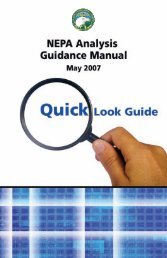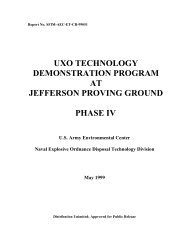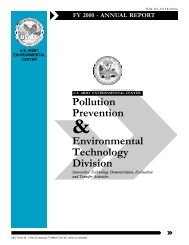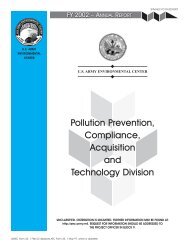(MRAP) Vehicle Program - U.S. Army Environmental Center
(MRAP) Vehicle Program - U.S. Army Environmental Center
(MRAP) Vehicle Program - U.S. Army Environmental Center
Create successful ePaper yourself
Turn your PDF publications into a flip-book with our unique Google optimized e-Paper software.
<strong>Army</strong> <strong>MRAP</strong> <strong>Vehicle</strong> <strong>Program</strong> <strong>Program</strong>matic <strong>Environmental</strong> Assessment December 2010<br />
air quality. This could include excessive dust generation from cross country driving or<br />
encroachment by surrounding population areas where public exposure would be an<br />
increased risk.<br />
The automotive lead‐based batteries used in the <strong>MRAP</strong> vehicles could be exposed to<br />
extreme conditions such as high heat or flame and could consequently expel<br />
hazardous/toxic fumes. In the unlikely event of damage or explosion of batteries, the<br />
amount of fumes released would be minor and would not present a threat to air quality.<br />
The <strong>MRAP</strong> FoV does not contain nor use Class I ODCs.<br />
<strong>MRAP</strong> training programs include vehicle maintenance activities. The maintenance activities<br />
do not occur continuously, but rather, the training occurs on a periodic basis. Additionally,<br />
the training activities focus primarily on removing and replacing components on the<br />
vehicles, and these vehicles’ maintenance activities require limited use of solvents and<br />
adhesives. The solvents and adhesives contain hazardous materials, such as HAPs and VOCs.<br />
A listing of the solvents and compounds can be found in the hazardous materials lists in<br />
Appendix B. When compared to other military vehicles’ maintenance procedures, <strong>MRAP</strong><br />
vehicle maintenance does not require the use of any unique or new materials or<br />
procedures.<br />
<strong>Vehicle</strong> painting activities are not planned as part of the vehicle maintenance during training<br />
activities. Likewise, vehicle maintenance training does not require the evacuation of the R‐<br />
134a from the ECUs or the release of the fire extinguishing agents.<br />
The majority of <strong>MRAP</strong> training does not involve use of solvents, cleaners, adhesives or<br />
other VOC and HAP containing compounds. Any maintenance training that does require<br />
use of those materials is limited in application amounts and exposure time to the air.<br />
<strong>MRAP</strong> vehicle emissions are comparable to heavy‐duty trucks. As a result, any impacts<br />
to air quality due to <strong>MRAP</strong> training are expected to be minimal.<br />
<strong>MRAP</strong> fielding consists of final preparation of the vehicles prior to shipment as well as<br />
support and maintenance activities after the units receive the vehicles. Deprocessing<br />
consists of the final preparation of the <strong>MRAP</strong> vehicles prior to the military units<br />
receiving the vehicles. The preparation would involve the necessary vehicle<br />
maintenance and completion of final vehicle integration activities. Efforts typically<br />
consist of filling vehicle fluid reservoirs, attaching vehicle components and ensuring the<br />
vehicle’s integrated systems operate according to specifications.<br />
If required during vehicle deprocessing, the vehicle painting involves only touch‐up painting.<br />
Areas that require touch up painting are often less than a square foot per vehicle. Touch up<br />
painting would only require the use of the CARC topcoat. The topcoat and solvent<br />
containers are covered except during painting activities. This practice limits the amount of<br />
VOC and HAP emissions from the containers. If needed, complete repainting of the vehicle<br />
will occur during Sustainment Level Maintenance and take place in permitted paint booths.<br />
UNCLASSIFIED 32







